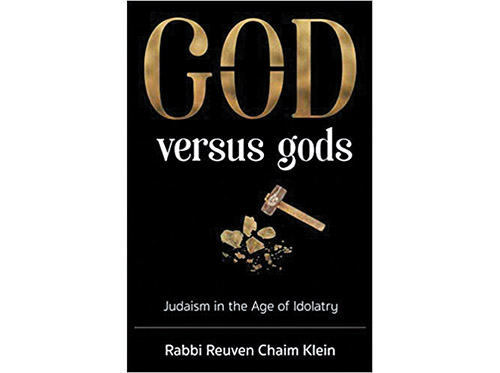
Reviewing: “God Versus Gods: Judaism in the Age of Idolatry,” by Rabbi Reuven Chaim Klein. Mosaica Press. 2018. Hardcover. English. 398 pages. ISBN-13: 978-1946351463.
The subtitle of Rabbi Reuven Chaim Klein’s remarkable study says a great deal about the immense task Rabbi Klein assumed in researching his fascinating book, “God versus Gods.” The subtitle, “Judaism in the Age of Idolatry,” sets an enormous challenge for anyone attempting to chronicle the role idolatry played in the religious culture and history of the Jewish people from biblical times until the destruction of the First Temple. With the Churban HaBayit, our sages teach that the worship of idols as an ancient cultic practice for all intents and purposes ceased. Over this lengthy time period, from mankind’s earliest days until some three and a half millennia later, Rabbi Klein offers an exhaustive and substantive account of how the Jewish people variously succumbed to and resisted, promoted and fought to eradicate this most pernicious of transgressions. Because there are few sins whose prohibitions are as many in the Torah as idolatry, and because this sin is the central focus of the prophets’ rebuke and chastisement in Neviim, the topic deserves careful and studious attention. Rabbi Klein’s work provides just that.
One’s first impression of the book is its reader-friendly format. The historical chronology is diagrammed on the front and back in-folds, making for easy reference. In Unit I, the time flow is divided into five epochs, each receiving in-depth treatment. In the “Genesis of Idolatry and the Guardians of Monotheism,” we read how our forefathers confronted the sin and sought to resurrect the Judaic monotheistic belief system against overwhelming odds. The sin of the golden calf and the Egyptian cultic worship is thoroughly analyzed, followed by the “Slippery Slope to Paganism” in the idolatry of the Kingdom of Israel. The penultimate chapter deals with the “Royal Blunders and Betrayal” in the idolatry of the Kingdom of Judah, which was one of the major causes for the Churban and subsequent Babylonian galut.
Unit II contains an invaluable encyclopedia of all the major deities mentioned in the Bible, each one discussed in enough detail to enable the reader to mark the differences among the ancient gods. Perusing the concluding bibliography gives one an indication of the extent to which Rabbi Klein researched not only our classic commentaries, biblical, Talmudic and post-Talmudic, but the many important secular sources he explored to draw a fuller picture of how scholars investigated this theological phenomenon of avodah zarah, idolatry.
It is refreshing to see how, in each of the chapters, Rabbi Klein effectively weaves together the biblical narrative with an analysis of how ubiquitous the lure toward avodah zarah was in the national and private lives of the people. Secular sources are introduced and compared with our Masoretic traditions to create a nuanced and erudite analysis of a complex subject. The text is extensively footnoted with references from both Torah and academic sources, all of which flesh out in detail the discussions in the chapters.
I was particularly impressed with Unit I’s final chapter, “The End of an Age: Idolatry as Obsolete Superstition.” Although the Talmud (Yoma 69b) relates that the evil inclination that had seduced people toward idolatry was banished in the wake of the destruction of the First Temple, there were still some residual pockets where idolatry held sway. Rabbi Klein discusses how and why this phenomenon occurred and how even post the destruction, idolatry assumed different and more rarified forms. The confluence of the end of idolatry and the end of prophecy is also discussed with its implications for our generation. But what I found most intriguing was that apart from exploring the theological commonalities between idolatry and prophecy and their radical divergences, Rabbi Klein introduces us to what historians and archeologists have called the “Axial Age,” a period in the religious history of man that saw a pivotal shift in which “a pagan set of superstitions” was replaced by “more sophisticated theosophies to justify pagan behavior.” Rabbi Klein traces how ancient idolatry morphed into more modern expressions of the idolatrous impulse (pp. 263-73). The chapter ends with a fascinating discussion depicting idolatry’s final obliteration in the Messianic Era.
Of course, this concluding discussion is a tease and prelude to a much-anticipated Volume II in which the author plans to delve more deeply into the conceptual, theological and psychological underpinnings of idolatry; why it was once the most tempting and enticing of all Biblical sins; and how the Torah sought to wean mankind off these insidious ideologies. Rabbi Klein hopes to discuss how and why modern man is still afflicted with this ancient temptress and how Torah/Halachic Judaism provides the “tavlin, the curative spice,” to deal with this pervasive evil inclination. Other subjects such as astrology, witchcraft and demonology will also be investigated in Rabbi Klein’s forthcoming book.
All in all, Rabbi Klein, in this excellent study, has provided something for everyone. Well written and organized, both the Torah scholar and layman will find the collected information both fascinating and instructive.
The book will not disappoint.
By Rabbi Jeff Bienenfeld
Rabbi Jeff Bienenfeld holds an MA in Jewish Education from YU and, as a close disciple of R. Joseph B. Soloveitchik, received semicha from RIETS. He served as a pulpit rabbi for 39 years in the United States, most notably as the long-time rabbi of Young Israel of St. Louis.













